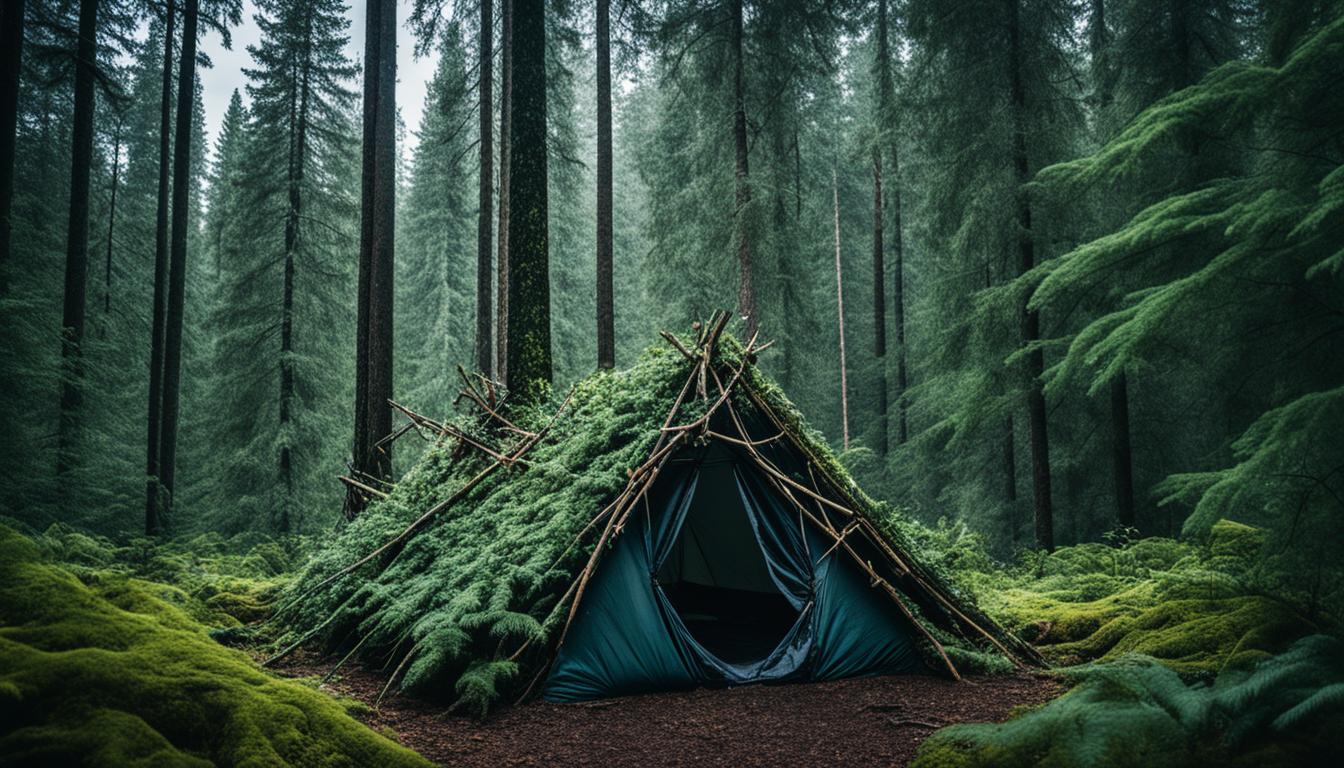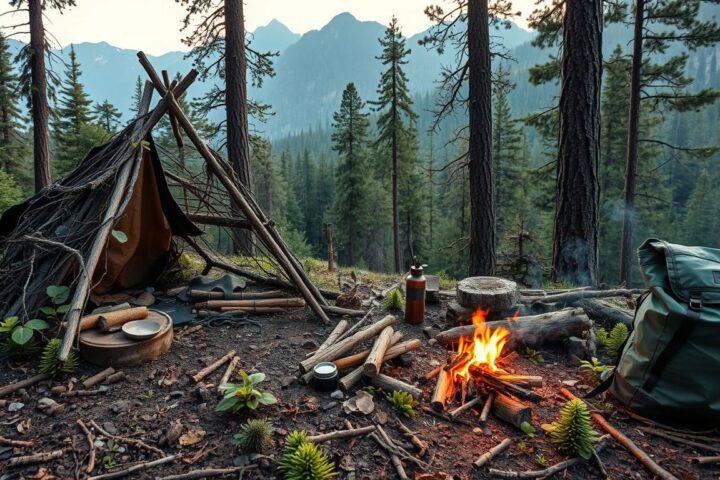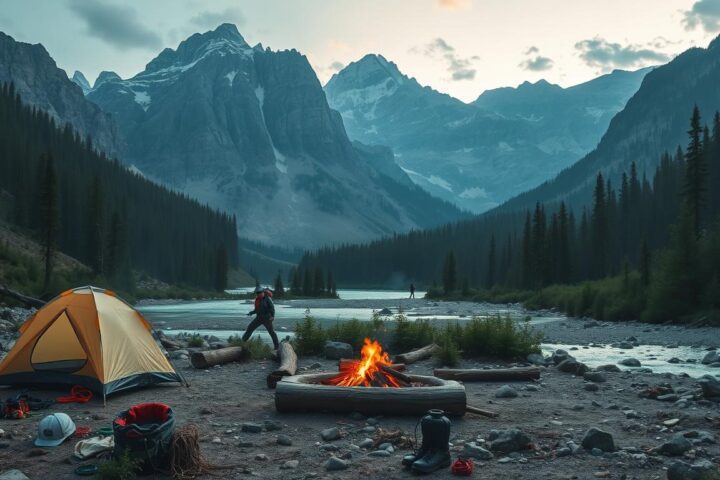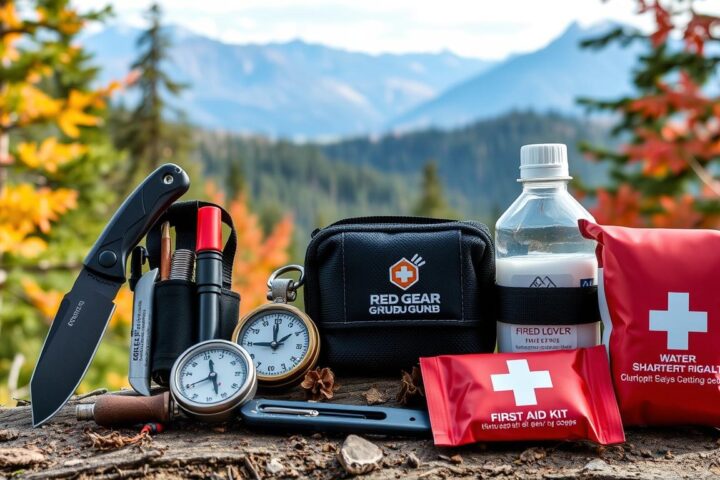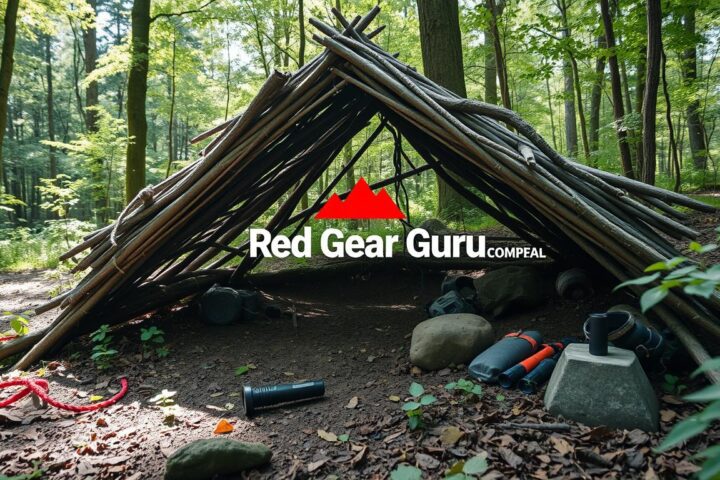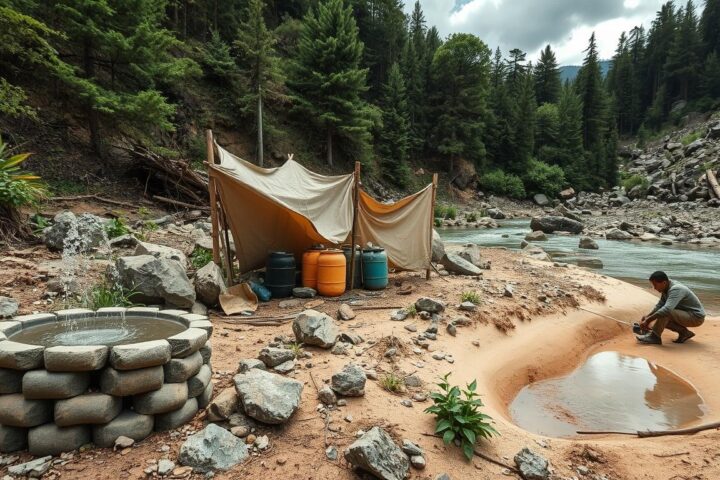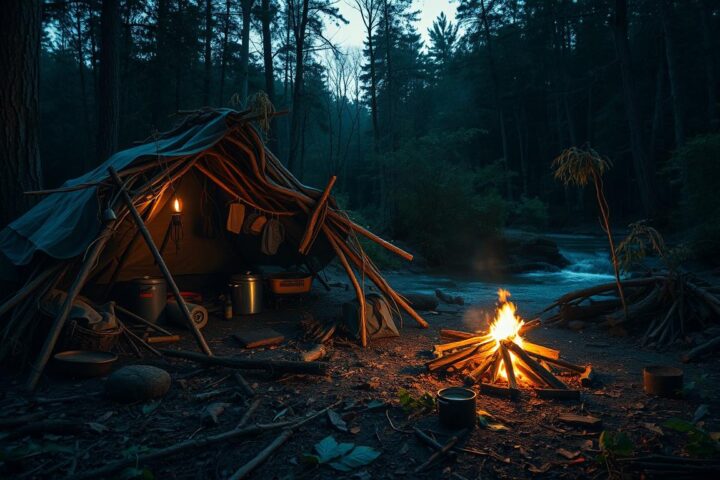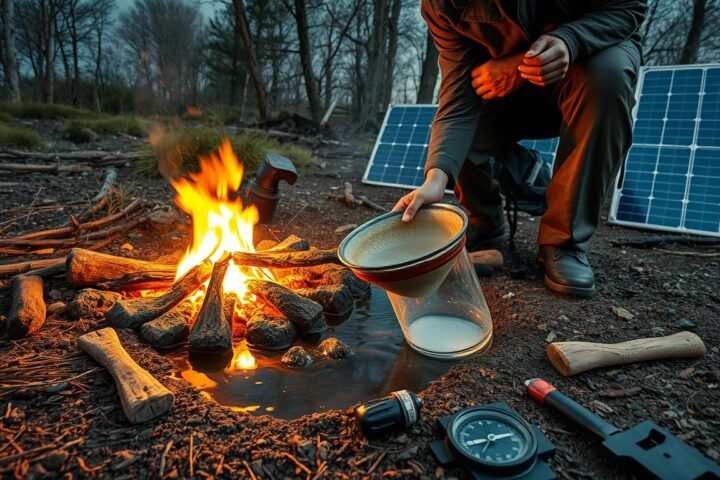Imagine you’re lost in the outdoors. What’s most important to keep you alive? It’s not food or water, but shelter. Most outdoor deaths aren’t from dehydration or hunger. They’re from losing too much body heat.
So, if you’re stuck in the wild, making a good shelter is crucial. It keeps you warm and safe from the weather. But do you know how to build a shelter that can save your life? Let’s look at the key skills and methods that could be lifesavers.
The Importance of Shelter in the Wilderness
Surviving in the wild means having a good shelter, along with water, food, and fire. Shelters are important but can be hard to carry. Yet, they keep your body warm and protect you from hypothermia, a big threat in emergencies.
The “3 and 30 Rule” says you can last 3 hours in bad weather, 3 days without water, and 30 days without food. This shows how vital shelter is for survival. A good shelter keeps you warm, protects you from wind and water, and helps with other survival tasks like starting a fire.
The Wilderness College teaches that building a shelter helps keep you warm by managing heat loss. It’s also key to use fire safely in shelters to avoid dangers.
As the Redgear Guru points out, a strong shelter creates a safe space against the sun, wind, rain, cold, and predators. This can be the key to survival in the wild.
Learning to build a survival shelter is a crucial skill. It can save lives and offer safety in the wilderness. Knowing how to build a shelter and its role in survival can really help in an emergency.
Dressing Wisely for the Elements
Choosing the right clothes is key to surviving outside. [http://tac.tui.mybluehost.me/diy-fire-starting-easy-tips-for-outdoor-enthusiasts/] Wearing layers of synthetic or wool helps keep you warm. This, along with a waterproof outer layer, traps heat and stops it from escaping.
Moisture-wicking materials like merino wool keep you dry and comfy. Fleece and down jackets help keep you warm, lowering the risk of getting too cold.
Don’t forget about your outer layer. Waterproof and windproof jackets keep you safe from rain and wind. Quick-dry pants and shorts help you stay comfortable as the weather changes.
Hats, gloves, and socks are vital for keeping your body temperature steady. Knowing how to pick the right sleeping bag is also key for a good night’s sleep. This helps you rest better and stay healthy on your outdoor trips.
Choosing the Right Spot for Your Shelter
When building a survival shelter in the wild, picking the right spot is key. Look for the driest ground you can find. Wet ground can quickly take away your body heat. High ground is also good because it keeps you safe from cold air and lets you see if people are coming to find you.
Find spots with natural windbreaks like trees or rocks to keep your shelter warm. But don’t pick deep ravines or valleys because cold air gathers there. By choosing wisely, you can make a safe and warm place to stay in the wild.
- Prioritize shelter site selection for the driest ground available.
- Choose a location with wind protection from trees, rocks, or other natural features.
- Opt for high ground to avoid cold air pockets and improve visibility for search parties.
- Steer clear of deep ravines or valleys where cold air can accumulate.
By following these tips, you can find the perfect spot for a strong and cozy survival shelter. This will keep you safe from the elements and protect you in the wilderness.
The Cocoon: A Natural Sleeping Bag
If you can gather dry leaves, pine needles, bark, or other forest debris hut shelter, make a natural “sleeping bag”. Pile it into a mound that’s two to three feet high. Then, burrow into the middle for natural insulation all around your body. This feels like having a sleeping bag without the need to carry one.
This debris hut shelter is often called a “cocoon”. It’s a great way to stay warm in the wild. By burrowing into leaf piles, you make a cozy, insulated space. This space traps your body heat and keeps you safe from the elements.
To make a cocoon shelter, follow these steps:
- Gather a lot of dry, insulating materials like leaves, pine needles, or bark.
- Create a mound that’s at least 2-3 feet high and wide enough for your body.
- Burrow into the middle of the mound, creating a hollow space for your body.
- Adjust the insulation around you to create a cozy, enclosed space.
- Make sure to leave a small opening for airflow to prevent carbon monoxide buildup.
This natural “sleeping bag” debris hut shelter gives great insulation and protection. You don’t need extra gear. Just pick a dry spot, and avoid places that might flood or get a lot of snow.
building a shelter in the wild
Building a strong and warm shelter is key for surviving in the wild. The debris hut is a great choice, made from sticks, branches, leaves, and moss. It’s a way to keep safe from the weather and save energy.
Start by finding a strong ridgepole for the shelter’s base. Then, make a debris mattress on the ground to keep you warm. Add ribbing sticks for support, and then weave a latticework with more sticks and branches.
Finally, cover the shelter with lots of insulating debris like leaves, grass, and moss. This keeps the shelter warm and traps heat inside.
- Locate a sturdy ridgepole to serve as the shelter’s foundation
- Construct a debris mattress on the ground for insulation
- Position ribbing sticks at intervals to provide structural support
- Create a latticework using sticks and branches
- Pile on thick layers of insulating debris, such as leaves and moss
A debris hut keeps you warm and dry in tough conditions. Its design helps keep you from losing heat and getting hypothermia. Learning to build a debris hut prepares you for any outdoor challenge.
Using a Tarp or Space Blanket
When you’re in a survival situation, having the right gear is key. A tarp, plastic sheet, or thermal space blanket can save your life. By learning to make a tarp shelter or use a space blanket, you can quickly create a safe place against the elements.
To make a tarp shelter, start by tying a line between two strong trees. Hang the tarp over the line, making sure it’s tight. Use rocks or logs to hold down the tarp’s edges, making it windproof. If it’s snowing, raise the line to help the shelter keep out the snow.
A space blanket is another great option for a quick shelter. Unfold it and use the shiny side to keep warm. Or, make a small tent by securing the edges with rocks or sticks.
Using a tarp or space blanket gives you protection from wind, rain, and snow easily. These simple shelters can be a lifesaver in unexpected storms or when you need a place to stay for a while. Always keep these emergency shelter materials ready.
Creating an Insulating Bed
Surviving in the wilderness means keeping warm by insulating your body from the cold ground. A “debris mattress” is a great way to do this. It’s made by stacking leaves, pine needles, moss, or other dry materials at least 8 inches deep.
This layer traps air and stops your body heat from escaping into the cold earth. It keeps your warmth in your shelter.
The debris mattress, or debris bed, is easy and effective for a cozy bed. It stops heat from leaving your body, keeping you warm. This helps you stay alive in the wild.
- Leaves
- Pine needles
- Moss
- Twigs
- Dried grass
Stack these materials at least 8 inches deep for a warm, insulating bed. This helps prevent heat loss and keeps you warm all night. A good debris mattress is key for a successful shelter. It keeps your body temperature up and prevents heat loss outdoors.
Avoiding Hazardous Shelter Locations
Choosing the right spot for your survival shelter is key to staying safe. Avoid areas with damp ground, exposed ridgetops, deep valleys, and flood zones. These places can cause heat loss, water damage, or even be dangerous to your life.
Also, stay away from tall trees that might drop branches, known as “widow makers.” These branches can hurt you badly or even be deadly. And, don’t go near the nests of stinging insects, as they can be a big threat to you.
- Steer clear of damp ground, exposed ridgetops, and deep valleys, which can compromise your safety.
- Avoid [http://tac.tui.mybluehost.me/gun-control-debate-understanding-both-sides-of-the-issue/]flood zones, as they can lead to water damage and other hazards.
- Stay away from tall trees that could drop “widow makers” – dangerous, falling branches.
- Keep a safe distance from the nests of stinging insects to prevent potential attacks.
By picking a good spot for your shelter, you can lower the risks and boost your chances of surviving safely in the wilderness.
Conclusion
Building a good shelter is key to surviving in the wild. It’s important to know how to use natural materials for insulation and protection from wind and water. This helps me make a shelter that can save my life in an emergency.
Having a shelter is crucial, along with finding water, food, and starting a fire. Together, these can really help me survive and get rescued. Learning how to build a shelter is a must for facing the wild’s dangers.
Knowing how to build a wilderness shelter is vital for survival. With the right skills and gear, I can make a strong, safe shelter. This shelter protects me from the elements and gives me a place to focus on finding food, water, and starting a fire.
Being able to build a good shelter shows I’m adaptable, resourceful, and ready for the wild. By improving this skill, I make sure I’m strong, safe, and ready for whatever the outdoors throws my way.
